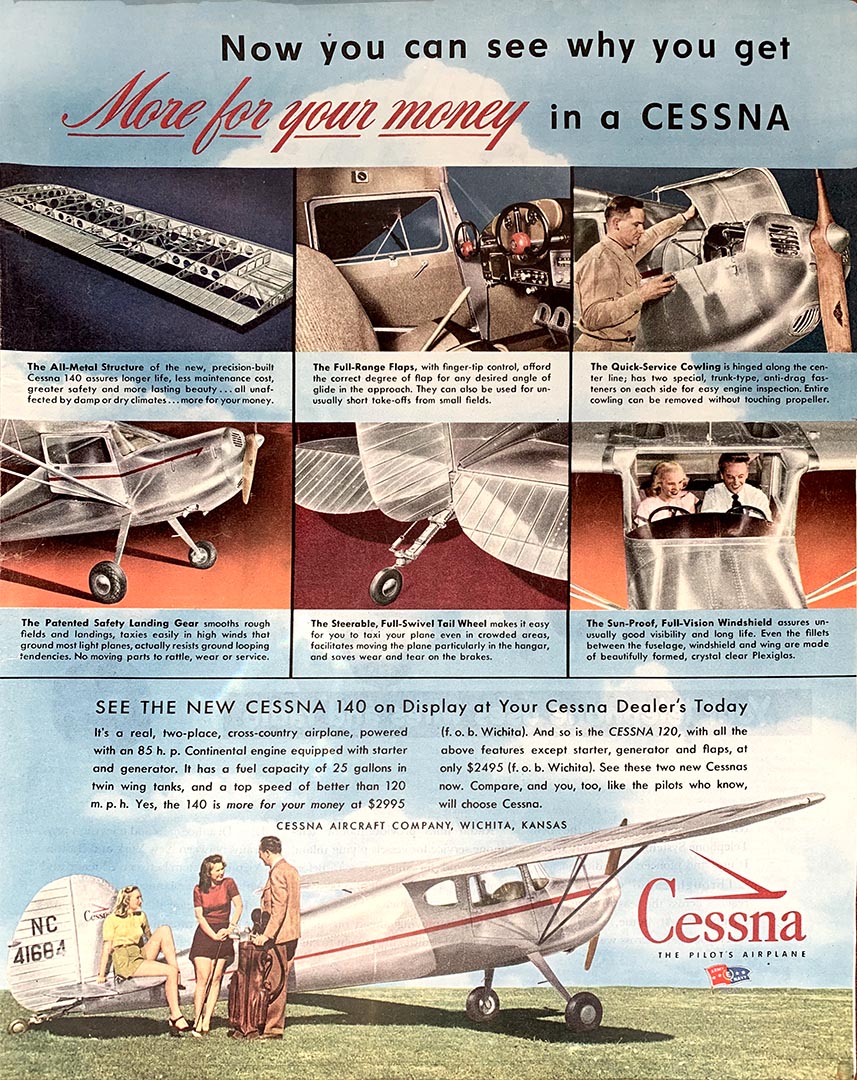Cessna or Seabee, pick your plane in 1946 and fly from land or sea
In the late 1940s, aircraft manufacturers hoped that military pilots returning from World War II would want to continue flying civilian aircraft for pleasure and sport. Cessna and Republic, two big suppliers to allied forces, switched their 1945⁄46 production lines from military aircraft to civilian and they advertised their new civilian aircraft in these advertisements from the March 30, 1946 issue of Collier’s Magazine.

What better than a real, two-seater, cross-country airplane
that sold for less than $3,000.
The Cessna 140 was the answer with its all-metal structure, full-range flaps, quick-service cowling, patented safety landing gear, steerable tail wheel and sun-proof, full vision windshield. What wasn’t promoted was the cramped space afforded the pilot and passenger. But they were flying!
Production began in 1946. In the next five years Cessna sold 7,664 in two configurations – the Cessna 140 and the Cessna 120. The latter didn’t have a starter, generator or flaps.
The taildragger —named “Outstanding Plane of the Year” in 1948 by the US Flight Instructors Association—was comparable in size to the 1946 Cadillac automobile. It was 21ft 6 inches in length and 6ft 3inches high. The Cadillac was 18’ 4” long and 5’ 3” high. Fuel tank capacity for the Cessna was 25 gallons in two wing tanks; the Cadillac’s tank held 20 gallons.
The automobile out-powered and out-weighed the plane with its 112 h.p. engine compared to only 85 h.p. and a weight of 4,500lbs to 1,450lbs
Read the history of the
Cessna and Clyde Cessna
the company’s founder
Here’s a link describing
what it was like flying the Cessna 140
The International Cessna 120–140 Association is an all-volunteer group of approximately 1,000 owners, pilots and others who share a common interest in restoring, maintaining and flying the Models 120, 140 and 140A aircraft manufactured by the Cessna Aircraft Company in 1946–1951. Though over sixty years old, these aircraft provide a combination of performance, ease and economy of operation and maintenance unmatched by many currently produced aircraft. Visit their website HERE
It’s a written post by Bill Cox on the blog of the Cessna Owner Organization. If you have any interest in flying then you must read Mr. Cox’s post. He notes: “The 140 wins rave reviews not because it does any one thing better than other airplanes, but because it does everything well. In short, it’s among the best at being average or better.”
Here’s a link to a video of Terri Hall flying her 1946 Cessna 140 with Dewey Davenport in 2017. Enjoy the flight.
Republic Aviation ran this advertisement for the Seabee, in the same issue of Collier’s

bassThe advertisement describes the Seabee Amphibian as an ideal post-war personal plane, versatile in performance, modestly priced, designed to go anywhere. Anywhere? Consider this:
“Buzzards Bay . . . as you take off in the salt tang of dawn . . . sunsets reminiscent of Remington . . . a few Gallic days at Chateau Frontenac . . . Wing your way up the historic Mohawk, high over the Barge Canal . . . Lake Placid for the winter sports . . . Pitch your tent when the small mouth are jumping in the Wisconsin Dells . . . that trip to the Shenandoah you’ve always planned for . . . Washington Airport, prelude to an official visit . . . New York, Chicago, Detroit, San Francisco, Seattle or just a taxi strip in the old home town . . . your own weekend schedule of lazy hours, a thousand and one vacation or business spots anywhere . . . can be reached from where you are . . . if you go the SEABEE way . . . $3995. Flyaway Factory.”
The Smithsonian Air and Space Museum The Museum acquired a Republic RC‑3 Seabee in 1984 from Robert N. Stiner, who had owned it for the previous fifteen years. In describing the Seabee, the museum noted that the plane was discontinued just two years after this advertisement ran and with only 1,076 planes sold:
“The Republic Seabee amphibian was one of the most unusual airplanes to appear on the post-World War II general aviation scene. It was designed as an affordable, all-purpose sport aircraft for transportation as well as a wide spectrum of recreational purposes. The sea/landing capability not only broadened travel options but also provided remote access to fishing, hunting, and many sporting activities, and 1,076 of the aircraft were constructed before a collapsing market terminated its production by Republic in 1948. However, many Seabees are still flying and they remain popular with seaplane pilots.”
Visit The Republic Seabee Amphibian website—with countless photographs, news, history, and specifications that document the history of the Republic Seabee and the story of her designer, the legend Percival Hopkins ‘Spence’ Spencer. And here are two other links with more facts about the Seabee:
Air & Space Magazine in June/July issue 2017 carried an article about
the Seabee written by Robert Bernier
Aircraft Canada of Calgary imported a Seabee from USA on July 1, 2010 and listed it for sale at $135,900

And what were commercial airlines flying in 1946?
You can read about it in this post that asks what happened to the promises that air travel would be luxurious and passsengers would relax in great soft armchairs.











